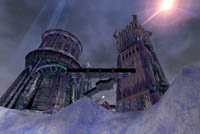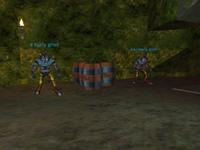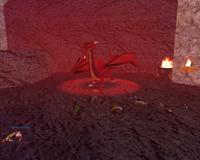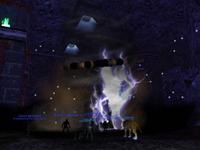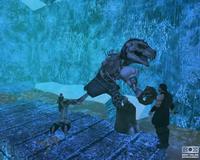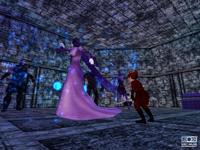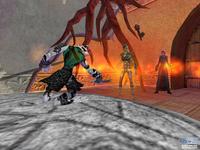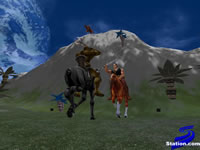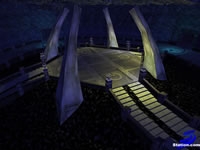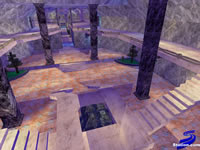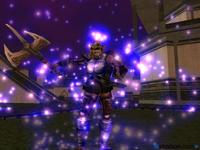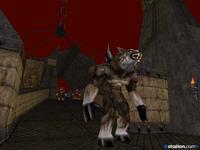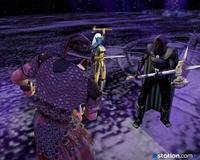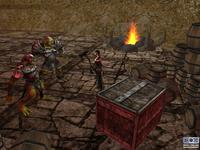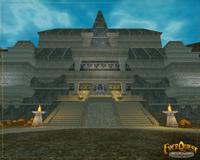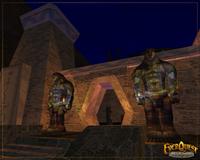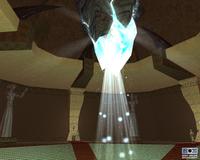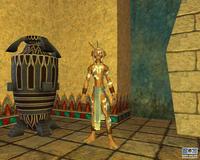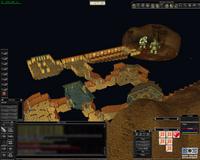|
|
|
Main News Forums Games Games Database Top 100 Release List Support Files Features Reviews Previews Interviews Editorials Diaries Misc Download Gallery Music Screenshots Videos Miscellaneous Staff Members Privacy Statement |
Everquest Review
Getting Started A challenge and boon with EQ when starting out is the sheer amount of content available to the player. The seven expansions to the "Old World" are The Ruins of Kunark, The Scars of Velious, The Shadows of Luclin, Planes of Power, The Legacy of Ykesha, Lost Dungeons of Norrath, and Gates of Discord. Each expansion added content and in many cases continents to the world of Norrath. Without the necessary expansions, certain content cannot be experienced. For those interested in getting a jump on the game, there are several combination sets available that allow you to purchase the original game and several of the expansions at the same time. The most comprehensive of these is the just announced Everquest:Platinum. It includes all the expansions through Gates of Discord for 30 bucks. Mapping features, graphical and client upgrades, and user interface additions are spread out among the expansions in addition to the changes in the gameworld. While some of you may balk at the need for frontloading all this extra content, you have no need to worry. Everquest is a fairly cheap game to get into compared to newer MMOGs. Installing and patching EQ can be a lengthy process, but is no where near as long or as complicated as the installation for Final Fantasy XI. One final update should be made before gameplay begins, as Everquest now supports DirectX 9.0. Updating your video drivers are a must in order to get the most out of your gameplay experience. Note for July, 2004 - At the moment, there is no excuse for you. If you want to try Everquest, you can now do so for free for 30 days. At the Official Everquest Site, you can download the original game plus the Scars of Velious and Ruins of Kunark expansions. This account will allow you to experience much of the original EQ content for free for 30 days. If you're interested, there are no more ways out of it. Go ahead and give it a shot. Creating a Character Creating a character in Everquest is a lot like choosing an ice cream at Baskin Robins. You know there's a difference between Chocolate-Chocolate Chip and Chocolate Chip-Chocolate, but you can't put your finger on it. If you are fully fleshed out with all the expansions, you have a whopping fifteen races to choose from. Humans, Barbarians, Dark Elves, Dwarves, Gnomes, High elves, Half Elves, Haflings, and Wood Elves make up the fairly cookie cutter races available to you. You can also play two brutish and stupid races, the Ogres and Trolls, the mystically inclined Erudites, and the animalistic Vah Shir, Iksar, and Frogloks. Each race is restricted to only choosing among a few of the sixteen classes available to you. The evil lizard-like Iksar, for example, can choose to be Monks, Warriors, Necromancers, Shadowknights, or Shaman. The other classes available include Bards, Beastlords, Berserkers, Clerics, Druids, Enchanters (buff/debuffers), Magicians (summoners), Paladins, Rangers, Rogues, and Wizards. There aren't a whole lot of options available to change the physical attributes of your avatar, but each class/race combination has a different look. Thus, even if you and your friend are both 1st level Gnomes, if you choose different classes you'll end up looking pretty different. One frustrating holdover from the earliest days of MMOG-dom is the need to assign points between some of your attributes. Each class has a few primary attributes that you can choose to assign points into at character creation. The issue is, they don't tell you what's important. So, though it may seem like a good idea as a warrior to put all of your points into dexterity, it really isn't. Within EQ the Warrior is a walking wall, and any points not put into stamina at character generation are basically wasted. There are an endless parade of character creation guides online for EQ, so I suggest looking into one if you haven't played before. Even with the 9.0 DirectX improvements, character models are still looking a little old-skool. By the end of the year, new models and more customization options are going to be available for Everquest players to sink their teeth into. These new models will take advantage of the DirectX technology and should result in some excellent looking PCs. Once your character has been created, you have the option to go through a tutorial to familiarize yourself with the controls and interface Everquest boasts. The introduction is surprisingly good. It offers a helpful voiceover and a waypoint system to move you through the area. It walks the first-time player through nearly every aspect of the game, from chatting to questing, from vending to combat. The area also features an interesting storyline revolving around your character's capture by a kobold band. To be honest, small quest and plot heavy areas like the tutorial zone would be interesting additions to the game in general. It is far and away one of the best MMOG tutorials at the moment, and even though the interface can be intimidating no first time player should arrive in Norrath unprepared. Graphics and Game World The recent graphics upgrade is a huge change for Everquest. The content where it has been put to best effect, the recent Lost Dungeons and Gates of Discord expansions, is beautiful. The models in GoD especially are very expressive, with facial animations, particle effects, and excellent looking equipment. On the other side of the coin, the "old world" is definitely showing it's age. While the 9.0 improvements have made the original continents look better, they are simply not up to today's graphics standards. Like the character models, the old world is going to undergo graphical improvements in the months and years to come. SOE's stated goal is to one day have all of Norrath looking as good as the Gates of Discord content. For the moment, though, blocky snakes and polygonal wolves inhabit the old continent of Antonica. Be prepared for a blast from the past as you start your travels through EQ. The Game World of Norrath is broken up into distinct continents, several of which have been added to the game in expansions since launch. Along with the continents have been added new races, new plots threads, a bevy of items, and dozens upon dozens of nasty critters to kill for those items. Everquest's 5 years up and running has resulted in what is likely the richest plot background for any Massive game on the market today. From the war with the gods that marked the Ogres, to the opening of Luclin, from the invasion of Grobb, to the revelation of the Wayfarer's Brotherhood, and recently to the discovery of the continent of Taelosia, Everquest and Norrath are always changing. This distinctive plot flavour is supported by literally thousands of quests that are offered by the hundreds of NPCs that inhabit Norrath. Some EQ NPCs, such as the irrepressible Fippy Darkpaw, have become well known and beloved enough to appear in other mediums. The downside of all this content is the possibility that you'll be overwhelmed. EQ does not, even after all these years, feature a quest log of any sort. So when talking to NPCs you'll have to remember who said what, who asked for your help, where they were and what they wanted. The method by which you interact with NPCs also feels a little cludgey. NPC dialogue has highlighted selections of text. To further explore a conversation with an NPC, you have to regurgitate that line of text in earshot of the NPC. It can be a hit or miss process to figure out if you're saying the right thing. Not only that, but they may not talk to you at all. Many NPCs and monsters in Everquest functions off of the "faction" system. When you kill an enemy that participates in a faction, or aid a group that opposes a faction, your standing with the faction falls. As you gain and lose faction with the various groups on Norrath, things become easier with the groups you have good faction with, and harder with the groups you have bad faction with. Good faction groups will offer you discounts on goods and will offer you more involved, rewarding quests. Bad faction groups will charge you more for goods and may eventually become "K.O.S.", or Kill On Sight, to you. Your faction standing and the relation of faction to quest giving is sometimes hard to understand. The extensive documentation available on fansites is always helpful in working out why someone won't talk to you. The content, quests, and NPCs are all set against the backdrop of Norrath. The continents of Antonica, Faydwer, Kunark, Odus, Velious, Taelosia, and the moon called Luclin are all broken into discrete zones. These zones are geographically disparate areas, usually separated by natural barriers like mountains or seas. Within the zones themselves, you're likely to find a good deal of variety. There are almost no single "purpose" zones in Everquest. Each zone has nooks and crannies in which there are pocket ecosystems, castles, towers, lakes, or dungeons to explore. Everquest is practically a handbook on how to do interesting zone design. EQ Zones have a variety of level ranges, ensuring that favoured hunting spots can be used for more than just one or two levels, and there are always a plethora of monster types to poke with pointy sticks. Zone design and monster placement are two areas where Everquest really still shines. Players come back again and again to old stomping grounds with fond memories of battles fought, won, and lost. Pretty good for a nonexistent place in a fantasy-land.
Those zone design principles are sharpened to point in the incredibly popular Lost Dungeon zones. While many of the expansions are worthwhile for the additional content, Lost Dungeons of Norrath is a must-have because it literally changes the way that the game is played. LDoN introduced the concept of instanced zones to Norrath. Instancing, if you're not familiar with the concept, allows a small group of players to claim their own personal pocket zone for adventuring. Any character not inside the group is not allowed into the zone. These personal dungeons are obtained via a really engaging quest element, the Wayfarer's Brotherhood. This band of hearty souls set up camps near adventuring hotspots. There are several camps spread throughout Norrath, and the adventures at each camp have their own flavour. One camp sends you into the depths of the frozen
At these camps, you can get in touch with individuals who can set up groups of 4 to 6 adventurers with personalized missions. Any player level 20 or higher can participate, and the adventure is tailored to the power level of the group. These quests are usually well written, and can provide some motivation when mindless slaughter of fuzzy critters becomes old hat. Above and beyond the individuality of the quests and the motivation they can provide, Lost Dungeons quests are usually lucrative propositions as well. Successful completion of LDoN quests nets you points within the Wayfarer's brotherhood. These points, once you've accrued enough, can be turned in for some very decent equipment. Above and beyond rewards after the fact, loot from the dungeons is usually quite good. The loot that isn't worth keeping isn't a loss either, as it sells well. Some players spend the entirety of their adventuring career after level 20 exploring the instanced halls of the Lost Dungeons, and it's easy to see why.
Sound and Music
Like all the sound elements to a Massively Multiplayer Game, Everquest suffers because of the length of time you'll be experiencing them. Sound effects and musical tracks that are interesting or refreshing the first few times will get extremely grating after only a few weeks of play. That said, there are some excellent musical selections in EQ. The Planes of Power tracks are all very well composed, and quite stirring. Some of the old world music has become fan favorites. The giddy melody that pervades Rivervale is especially enjoyable.
Similarly, the sound effects within the game are generally enjoyable, but can get repetitious. The only sound effect no one ever tires of is the distinctive clang that sounds when a level is gained. Ding!
To combat sound-weariness, Everquest comes with a built in mp3 player. This allows you to play through the realms of Norrath to your own music collection. If you find yourself in Befallen late at night, I highly suggest Danny Elfman. But that's just me.
Gameplay and Interface
Despite the rich plot background I mentioned, questing in Everquest has always struck me as a somewhat lackluster affair. While the quest plots can be very engaging and will definitely get you into the thick of the story in Norrath, I've never felt a lot of motivation to quest in EQ. There is a limited quest log that allows you to keep track of what NPCs say to you and where they say it. It has to be turned on, though, and can be kind of awkward to use. With the conversation tree method of obtaining quests it's also very hard to know what lies ahead on your path as an adventurer. Which is not to say there aren't goals, of course. In EQ, the goals are very material. More and better equipment and more platinum (money) are the goals you can look forward to. That said, there are certain quests that stand head and shoulders above the rest. These are quests that almost all EQ players are aware of, if only tangentially. The most famous of these are the epic weapon quests. These were introduced for the express purpose of providing an "ultimate" weapon for each class. Over the years the epics have been supplanted by more powerful weaponry in subsequent expansions, and the quests to obtain them have become somewhat obscure. In the upcoming expansion, Omens of War, a new series of Epic Weapons and the quests to obtain them will become available to every character class. These will be career pinnacle events, according to Sony. The difficulty of completing the quests and the power of the weapons will make the characters who bear them like tiny gods. Or so the PR would have us believe.
With quests by themselves being somewhat interchangeable, zones and the character of the zones makes for some of the backstory when players swap tales. Certain areas of Norrath have become so well known as to be legendary among the player populace. While the Guild raid areas on the Planes such as Hate and Time are well known for their difficulty, lower level zones have their own mystique and fans as well. The Gnoll den zones of Blackburrow and Splitpaw are two areas that many adventurers remember fondly, if only for the chance to slaughter one of the most hated monster races in Norrath. Both zones also feature some fairly decent quests. Solusek's Eye and the associated areas (Sol A and Sol B) is home to one of the most powerful non-Planes creatures in the game, the Dragon Lord Nagafen. And, of course, there is the low level zone of The Crushbone Orc Camp. Crushbone is probably one of the most well known EQ zones, and with good reason. Interestingly laid out, well populated zones like Crushbone are one of the reasons that Everquest has become the institution it is today.
Besides straight adventuring, there are several crafting options that players can participate in. Crafting in Everquest for the most part centers on combining materials. Bat wings, horns, and such, are combined with other components to create clothing and armor, weapons, and magical items of all sorts. Some of the most powerful weapons and armor in the game are crafted from components obtained in high level areas. EQ also has a helpful recipe database that lists the items needed for a given item. Not all items you can create are on the list, however. Unique and high end items spring from recipes that are handed out by specific quest NPCs.
The default interface that Everquest utilizes can be a little clunky to use at first. Some of the more esoteric functions of the interface can take while to discover, even with the help functions. The tutorial, however, turns what was once incomprehensible for the first time user into a fairly easy process to deal with. Their is still a learning curve, of course, but it is considerably shallower with the tutorial in place than it once was. The control scheme is likewise easy to adapt to thanks to the accessible tutorial. The control scheme Everquest uses is, in fact, the standard that has been to one degree or another adopted throughout the industry. Players of other MMOGs will find it intuitive to use, and first time players will be well guided by the tutorial's helping hand.
Combat, Spellcasting, and Death
Despite the center stage that combat takes in Everquest, it is a fairly simplistic experience. The old MMOG adage "Hit A and walk away" comes from Everquest melee fighting. Once you're engaged at close quarters with a monster, simply remaining close to it while your character hacks away at it is all that's required. Warrior classes do have abilities to assist them in their duties, such as kicks and taunts. Once you've figured out a pattern, though, combat can get somewhat repetitive. The outcome of a fight is almost always predetermined by the game's rigid "con" system. The /con (or /consider) command, and colour coded circles under the feet of selected enemies, alerts you to the relative difficulty of the creature you face. Green, Blue, and Dark Blue fights are almost sure wins. White fights will be challenging but will probably see you victorious. Yellow and Red fights will almost certainly result in your death without some assistance. Some recent changes to the melee system have livened things up somewhat. At higher levels you gain the ability to gauge and take advantage of "openings" in your opponents attack routines. These openings dictate the use of specific abilities at specific moments, and can allow for massive damage if used appropriately. While the openings system has added some flavour to the game, melee is still a pretty dry experience.
Magic and pet using classes have somewhat more variety to look forward to. Everquest has one of the deepest, widest spell trees of any game on the market. Spells are purchased from merchants, and tiers of spells become available at certain level intervals. Reaching these tiers is very important for spellcasters, as a new tier can mean gaining access to over a dozen new spells. While many spells stay useful for a wide range of levels, old spells are gradually phased out by improved versions as you gain levels. The role a spellcaster takes is defined specifically by the spells he has access to, and for that reason some spellcasting classes have the novelty of evolving their role as they gain in levels. Druids in particular go through several role changes, wearing the caps of healer, nuker, and buff/debuffer alternately as they advance in their class.
These class roles are what saves the combat experience for Everquest. Beyond level 15 or so, it becomes increasingly difficult to play solo. Spellcasters are powerful but squishy, while melee types are strong yet vulnerable to debuffs. Every class has a specific role to play in a combat situation, and a group made of up several of the combat class types becomes an extremely effective combat machine. The concept of pulling was practically born in Norrath, and the roles that each class takes in the pulling chain almost always means that everyone has something to do. Over the years that EQ has been out there have been more and less popular classes. Largely this was due to perceptions of inequality among the classes, leading SOE to search for the elusive goal of "class balance". At the moment, SOE has a fairly good balance going on, and there don't seem to be any major beefs between the player community and Sony based on class balance.
Inevitably, however, combat results in death. Luckily for the first ten levels the game goes a bit easy on you. Your death has no xp penalty and you respawn with all of your equipment. Once you reach level 10, death results in a noticable experience penalty. This experience penalty can indeed reduce you back to a previous level if you're very near to the cusp. If you have a friendly cleric nearby, spell resurrection is an option. You reappear at your corpse with some penalties (call "rez sickness"). Then you can retrieve your equipment from your corpse. If you don't have a cleric, you will be introduced to a time honored EQ tradition: The Corpse Run. Instead of reappearing at your body, you reappear at the last place you "bound" yourself. Bind points are scattered throughout Norrath, and certain spellcasters can bind you to other locations using spells. From your bind point, you'll have to make the trip to where your corpse has fallen. Depending on where you died, this can result in having to traipse through monster infested environs for an extended period of time in order to recover your corpse. Some players keep a second set of armor and weapons handy for corpse runs. When you reach the area you left your body, it's possible to summon your corpse to you using the /corpse command. This works on a fairly hit or miss basis depending on how far you are from your body. If you trust the people you game with, you can give others permission to drag your body to a safe location. This does make for some odd sights in heavily hunted areas. Those are the dangers of MMOGs, I suppose.
Character Advancement
Character advancement in Everquest is, of course, through grinding. Everquest, as a template from which many other games have been created, is the original grindfest against which all other games are merely pretenders to the crown. To some extent, of course, that's no longer true. As their population has matured and the game has grown, SOE has taken steps to make the endless grind less soul-sucking. Additionally, the grinding philosophy of Final Fantasy XI is now available to compare against. But, truthfully, don't expect anything shocking about level advancement. Every time you've cursed the grind in another Massive game, you partially have Everquest to blame. Which is (of course) not to say that it isn't fun. In fact, solo grinding isn't nearly as onerous task as it can be in other games. Once you're past the mid-teens playing solo is not a wise idea, but it is possible.
At the highest levels, Everquest does offer something exciting to players. This addition to the usual grind is called "Alternative Advancement". Through AA, a player can tweak his character with additions to stats, skills, special abilities, and titles. If you've ever seen someone running around with "Baron" or "Baroness" before their name, they're participating in Alternative Advancement. These AA abilities allow your character to stand out from all the other Fighters, Priests, and whatnot. AA characters can have their own specializations and quirks that are totally unique from all other players. Hanging out in the communal area of the Plane of Knowledge is all the more interesting watching AA characters wander by.
Community (PVP and Guilds)
As much fun as the game itself is, the best thing hands down about Everquest is the incredible community of people who play it. Far from the miscreants, misanthropes, and social rejects that the popular press populates Norrath with, Everquest is played by friendly, interesting, normal folks. The oft mentioned Norrathian Scrolls, a demographic study of EQ done by Nick Yee, shows that Everquest players are just regular folks with a lot of imagination. This evidence is definitely supported by the experience one is likely to encounter in-game. while every online game has it's bad eggs, the people of Norrath are overwhelmingly a friendly, helpful group of people. The passion and love of the game that EQ players exhibit draws them to assist new players as much as they reasonably can. Questions are usually answered in a respectful manner if they are respectfully asked, and the kindness of strangers is evident no matter what zone you find yourself in.
The backbone of the player community is made up of the many Guilds across the many servers. More than perhaps any other modern MMOG, Guilds are the life and breath of Everquest. There are many Guilds across the length and breadth of Norrath and they fulfill social niches of all kinds. Trade guilds, racial guilds, class guilds, social guilds and more...the EQ player who wants to hook up with other people has many options to choose from. Guild creation has minimum requirements in Everquest, and a minimum number of players to perpetuate the guild. Chances are good that a functioning Guild will be fertile ground for a player looking to expand his gameplay experience. Guilds fundamentally add to the gameplay experience, and are a well implemented part of the Everquest social structure.
Player vs. Player combat in Everquest is, on most servers, entirely voluntary. A group of NPCs known as the "Priests of Discord" exist throughout Norrath. When a character is created, they're provided with a document which can be handed to a Priest to signal a character's willingness to participate in PvP. From that point onward, the character is flagged PvP enabled, and can be attacked by anyone else who has signed up with the Priests. This is on the standard server sets. One of the most interesting aspects of Everquest is the different rules-sets used across the servers. One group of servers is dedicated to PvP player. These servers all have the word "Zek" in their name and are referred to collectively as...the Zek servers. Each of these servers utilize a variant of a rules-set wherein all characters are PvP enabled. On each server, there are different goals for the various players. One server is a race-war server, where the different races war against each other. Another server pits religions against each other. Players who enjoy challenging others in online warfare will find many opponents and rule-sets to challenge them in Everquest.
I said initially that the length of time EQ has been out and the amount of content available can be intimidating. The flip side of this intimidation factor is the sheer amount of information that is available via fan-run websites. Items, quests, monsters, zone maps and NPCs are available via sites like Allakhazam's Magical Realm, and The EQ Atlas. The sheer amount of information available about the game is honestly something to take into account when considering the game. For good or ill, the players of Norrath have exhaustively cataloged their world. Keep that in mind when you're thinking about playing. You'll never be stuck...but it's possible you'll never be surprised either.
Conclusion
Five years is a long time. Over those years, Everquest and the folks running it have encountered numerous challenges and accrued many successes. Ultima Online and Meridian 59 may be longer in the tooth, but I doubt that any other game can claim to have had as much of an affect on Massive games as Everquest. With this age and respectability has apparently come wisdom as well. Sony Online has begun a campaign to integrate the player base with the people making the game, incorporating the best ideas from the people who interact with the game the most into the plans of those who make it. The recent Guild Summit was supposedly just the first in a long line of changes being made to truly make Everquest a player's game. Atop this philosophical shift lies a commitment to graphics upgrades, content additions, and yet more expansions. Despite the fact that it's no longer #1 in the subscriber fight, Everquest is still one of the most venerated of MMOG titles.
The Verdict
The ups and downs:
Reviewer's System
|
|||||||||||||||||||||||||||||||||||||||||||||||||||||||||||
|
All original content of this site is copyrighted by RPGWatch. Copying or reproducing of any part of this site is strictly prohibited. Taking anything from this site without authorisation will be considered stealing and we'll be forced to visit you and jump on your legs until you give it back. |
||




